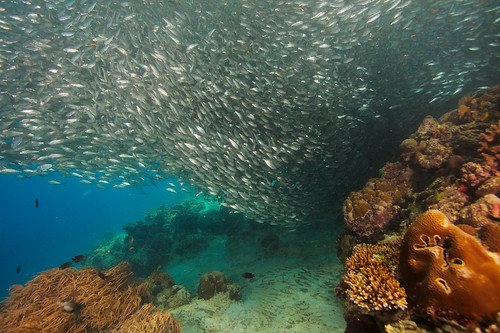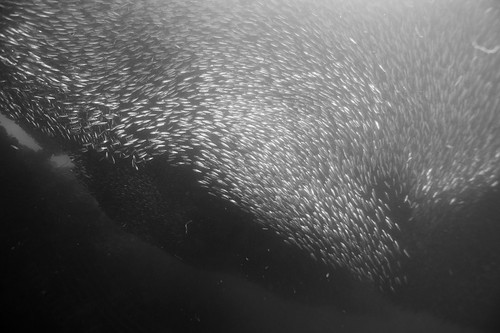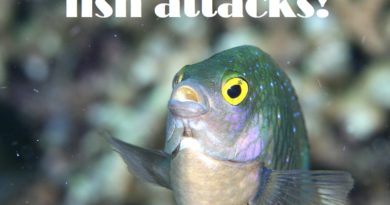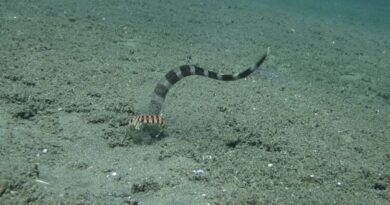Sardines, Death and Fear
I have the privilege to live in a region with one of the most biodiverse marine faunas in the world, on the island of Cebu in the Philippines. I get to spend plenty of time underwater, and one of the most fascinating things I see on my dives is a large school of sardines, located only a brief swim from my home on the Cebuano coastline. This school of sardines – my estimate is that there are several 100 000 fish – has remained more or less in the same position for several years.
I don’t think that many of the original fish are left though, since they are vigorously hunted from above and below. Near the surface, meter-long needle fish prowl the perimeter of the school. A needle-fish looks like a really muscular pike, with a long spike on its nose – likely the last thing many sardines see in their lifes. From below, trevaleys hunt the sardines. These are silvery fishes shaped like an upright oval plate, with sickle-like fins and a serrated edge of their bodies for improved hydrodynamics. Trevaleys are powerful swimmers and usually travel in small groups (less than 10 fishes). They are such confident fish that they barely change direction when approaching a diver (a lot of marine fish are quite terrified of bubble-blowing humans). And every two weeks or so, divers report seeing an even more dangerous predator of sardines: a thresher shark. These are the most impressive swimmers I have seen in 25 years of diving – biological torpedoes with a tail fin almost as long as their body (up to 3 meters in total). With a barely noticeable flick of its fins a thresher shark can accelerate to move out of a slow diver’s sight even in ocean water with superb visibility.
 And to add to all these predatory fishes, from the water surface the planet’s most fearful hunter preys on the sardines: Homo sapiens. Fishermen in paddle boats catch their lunch with hook and line; thanks to a sanctuary motivated by a thriving diving tourism, net fishing is fortunately illegal in sardine land. The sardines perform a veritable underwater ballet in their efforts to evade all of the bigger fish which think of them as food, and not as relatives deserving some sympathy. They form sardine balls, arches, twirls and strings. These formations change in seconds. It’s a fish tornado. This is what makes watching them so enthralling. Undoubtedly these advanced schooling behaviors play tricks on the predators’ visual systems. But the well fed bodies of the trevaleys and needle fish around the school tell me that not all sardines escape. How does it feel to be prey? Do the individual fish in that school of sardines feel fear? Fear is most probably a highly conserved vertebrate emotion, given that bony fishes (like sardines) share some of the brain regions responsible for processing fear with us. The brain region most importantly implicated in fear and learning to fear is the amygdala. In the amygdala sensory information from the environment (what to fear?) converges with emotional information (when to fear?). There is a lot of very good neuroscience about the workings of the amygdala in rats. Based on the shared anatomy in different species, we can assume with some confidence that the basic principles of fear processing in the amygdala are somewhat similar in rats, humans and sardines (the homologous structure is called medial pallium in fishes, neuroanatomy is a discipline with a notoriously tricky terminology).
And to add to all these predatory fishes, from the water surface the planet’s most fearful hunter preys on the sardines: Homo sapiens. Fishermen in paddle boats catch their lunch with hook and line; thanks to a sanctuary motivated by a thriving diving tourism, net fishing is fortunately illegal in sardine land. The sardines perform a veritable underwater ballet in their efforts to evade all of the bigger fish which think of them as food, and not as relatives deserving some sympathy. They form sardine balls, arches, twirls and strings. These formations change in seconds. It’s a fish tornado. This is what makes watching them so enthralling. Undoubtedly these advanced schooling behaviors play tricks on the predators’ visual systems. But the well fed bodies of the trevaleys and needle fish around the school tell me that not all sardines escape. How does it feel to be prey? Do the individual fish in that school of sardines feel fear? Fear is most probably a highly conserved vertebrate emotion, given that bony fishes (like sardines) share some of the brain regions responsible for processing fear with us. The brain region most importantly implicated in fear and learning to fear is the amygdala. In the amygdala sensory information from the environment (what to fear?) converges with emotional information (when to fear?). There is a lot of very good neuroscience about the workings of the amygdala in rats. Based on the shared anatomy in different species, we can assume with some confidence that the basic principles of fear processing in the amygdala are somewhat similar in rats, humans and sardines (the homologous structure is called medial pallium in fishes, neuroanatomy is a discipline with a notoriously tricky terminology). 
Fear is felt by an animal if its existence is threatened. This situation is a daily routine for our sardines. But even though a sardine has the proper brain area for fear processing, does it live in constant fear? Do animals low in the food chain permanently experience fear? No, I don’t think so. Let me explain:
First of all, chronic fear is a detrimental to the body. Psychiatric disorders involving fear such as panic attacks are debilitating diseases, paralyzing the sufferer mentally. Fear is a warning signal that – based on the information the animal has access to – the danger to the animal is above it’s normal level. The chemical messengers released during times of fear help to activate every available resource to aid the animal in the escape from the fear-inducing situation. A permanent state of alarm with no rest robs the body of its resources. It would endocrinologically make no sense for the sardines to actually constantly fear their death, even though it is a constant presence, only meters away in the form of a hungry trevelay. In the big school I am not observing sardines weakened by a constant bombardment of stress hormones, but vigorously moving fishes. Evolution must have readjusted the baseline of danger in sardines. It would take a truly exceptional threat to make them afraid. The usual daily threats by the predatory fishes around their school are not worth ringing the special alarm bell called “fear” anymore.
Then there is also the question how much uniqueness dies when a sardine dies. They all surely look very similar, and are probably genetically closely related. In genetics, Hamilton’s rule argues that one’s death is worthwhile if it saves the lifes of sufficiently many close relatives. Two brothers share on average ½ of the genes; Thus giving your life for that of more than two of your brothers brings more of your genes into the future than if you had survived. For cousins, it’s at least four you have to save with your heroism to make it genetically worth the sacrifice.
I don’t have any data on the mutual support the sardines I so enjoy observing provide to each other, and at what risk for themselves they provide this support. But it’s likely that the schooling behavior is a communal defense mechanism. When the outer wall of sardines shields their cousins during an approach of a predatory fish, they are doing something very sensible from a genetic point of view. They die knowing that genes very similar to their own continue to exist in countless other fishes.
I would think that the sardines feel calmness in the face of death – death up-close, in the shape of fast-swimming fishes many times larger than themselves, with pointy teeth. That these teeth are threatening to tear their bodies apart is a normal part of the day for them. This high likelihood of death is so routine that it probably does not evoke much fear in the sardines. They end their existence knowing (implicitly!) that their genes will live on in other individuals. The tribe will persist even if they perish. Sardinella sp. would have been the perfect WWI soldiers.
Naturally my statements about the lack of fear in the sardines’ minds are speculation. We can never look into the minds of other humans, and even less so into the minds of non-human animals with brains different from ours. This dilemma is so appropriately called the “fremdpsychische Problem”, the problem of foreign psyches, in German. There is, in principle, no way around this problem. We will never know for sure if sardines feel constant fear.
But neuroscience, endocrinology and genetics have allowed us to put our speculation on a scientific underpinning. Brain anatomy has shown us that bony fish have a brain region for handling fear, similar to our amygdala. Endocrinology tells us that permanent fear is harmful to an animal. Genetics has provided us with Hamilton’s rule, which tells us that dying is not that bad if relatives with some of your genes survive as a consequence of your death. Hence our speculation is at least educated speculation. If we speculate about a question where we could also observe and experiment to answer it, we are just lazy. When it comes to the contents of the minds of animals which branched from our phylogenetic lineage hundreds of millions of years ago, making sure our speculation is an educated one is all we can do.
Don’t fear the reaper. The sardines don’t, and their reapers swim around them every hour of the day.
And, yes, this is my submission for the 3QuarksDaily philosophy blog prize. It’d be nice to win some recognition, but I’m already thankful to the folks at 3QuarksDaily to inspire me to write about this topic. This essay is dedicated to my teacher of theoretical biology, the late Prof. Rupert Riedl, himself a student of the great Konrad Lorenz.


